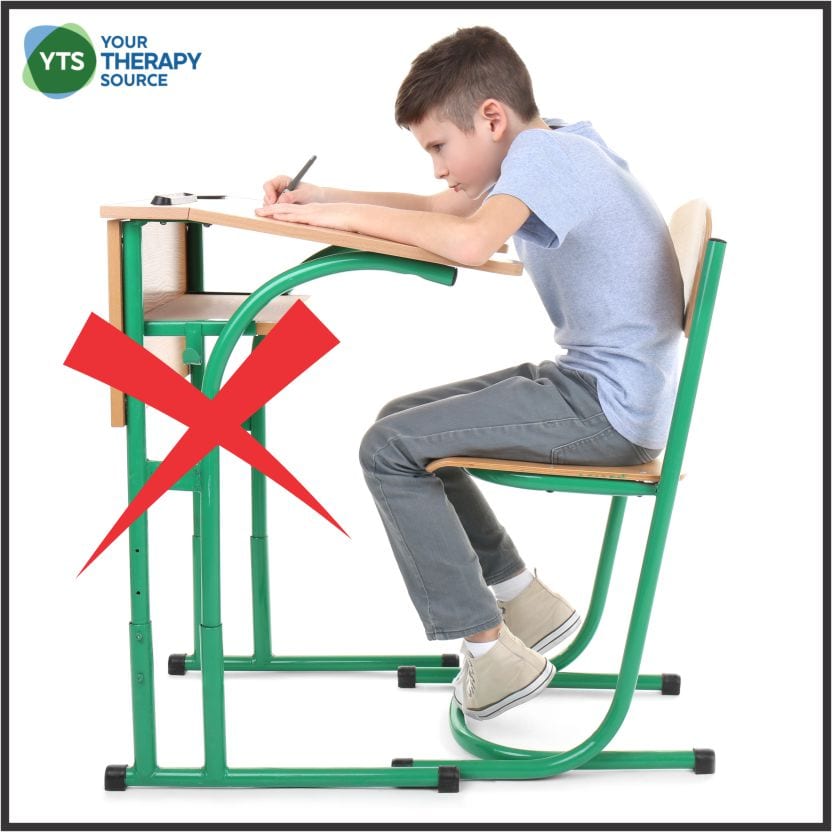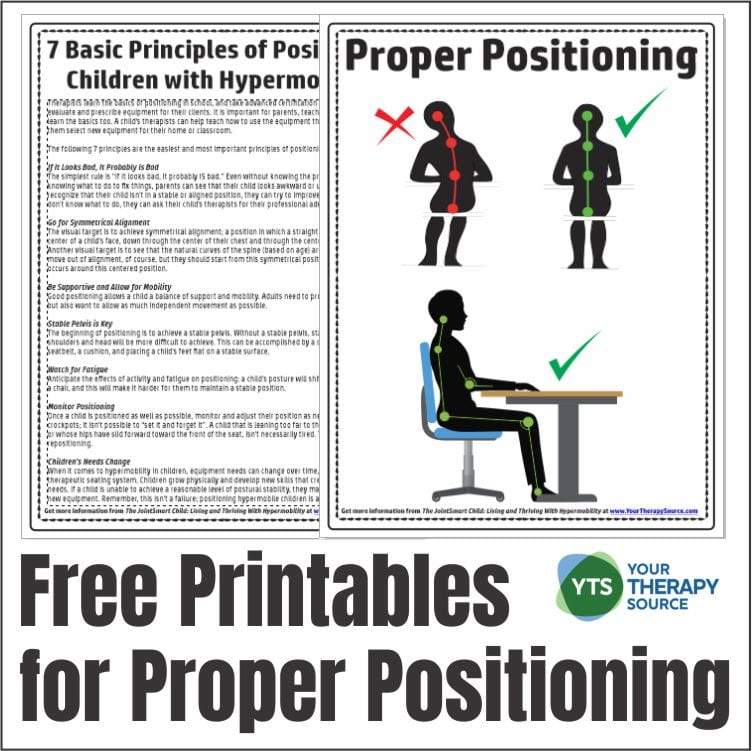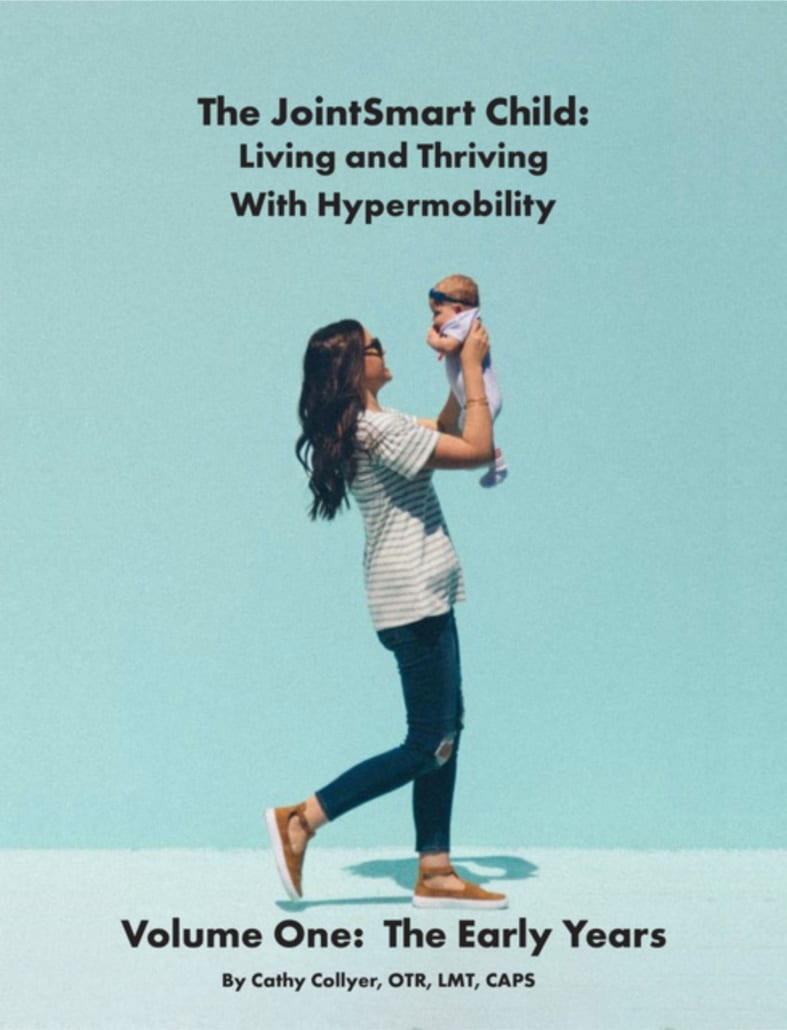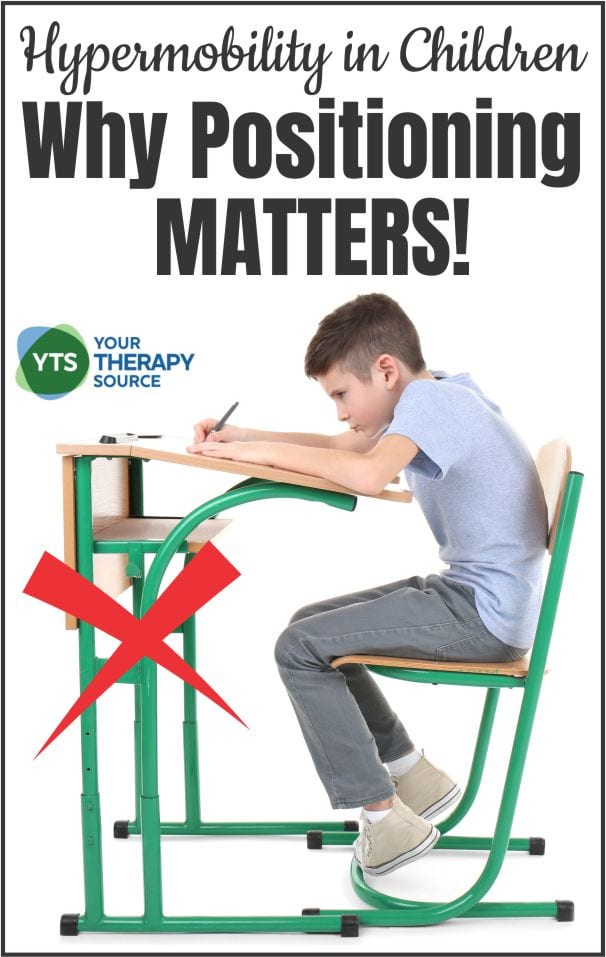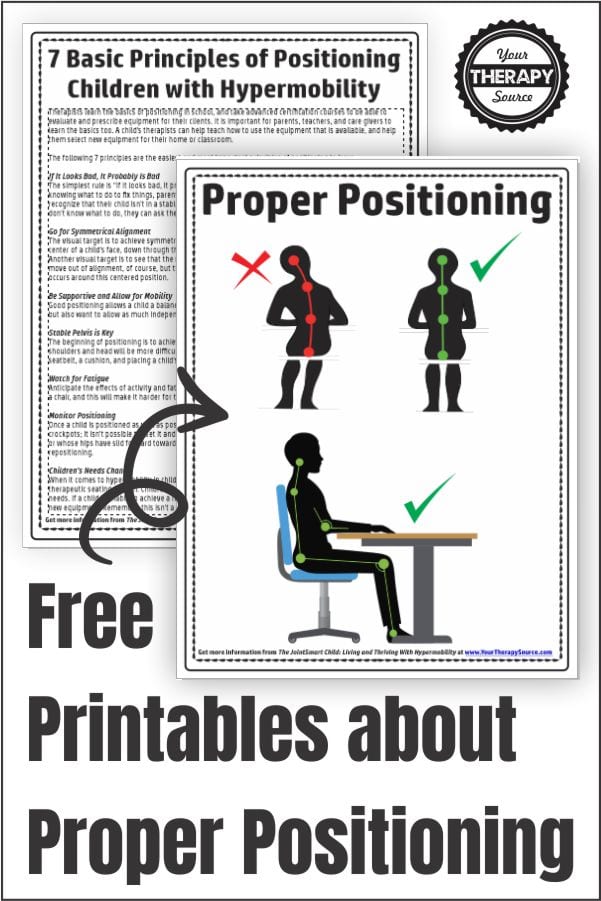Hypermobility in Children – Why Positioning Matters
When hypermobility in children is present, delayed postural control can sometimes be present. This means that due to the difficulty of stabilizing the head, trunk, and pelvis against gravity, a child may take longer to reach postural milestones such as holding their head steady, sitting without the need for external support, and standing independently. For example, a hypermobile toddler may still need head or shoulder support while being fed or while feeding themselves, and a preschooler may need a booster seat and a place to position their feet while eating, instead of sitting in an adult chair. Get your free printable handouts at the bottom of the post.
Benefits of Proper Positioning for Children with Hypermobility
There is a significant range of postural stability, endurance and pain tolerance with hypermobility in children. Good positioning means that a child has the right balance of support and freedom of movement, based on what they are doing.
The benefits of good positioning are significant and cover many areas of functioning and development, beginning with the most obvious benefit: improved safety. Falling and tripping are not the only safety issues for young children. They can be unsafe without being on their feet. In fact, parents will need to be more alert and provide more supervision when a child is on the move than when they are sitting.
If a child is unstable, they can spill hot food, injure themselves with scissors, or drop breakable items. Spilling a bucket of blocks may not injure a child, but walking around them or over them could create an injury. Beyond improved safety, good positioning can reduce a child’s level of fatigue, which indirectly improves their safety. Tired children, or children who use compensatory patterns of movement, are much more vulnerable to injury.
Good positioning can help a child activate the correct muscles and use optimal movement patterns. This could help them build strength and stability more easily. Optimal positioning can help a child develop the ability to use both hands and allow them to use the most mature grasp patterns available to them at the moment.
The well-positioned child may be able to visually focus and pay attention for longer periods of time. A child’s speech therapist knows that a child’s vocal control is maximized when they are able to stabilize their body during speech.
Children who feel stable are less fearful and more social. They need less supervision from adults, and can develop a strong sense of independence and curiosity as they explore their environment.
7 Basic Principles of Positioning with Hypermobility in Children
Therapists learn the basics of positioning in school, and take advanced certification courses to be able to evaluate and prescribe equipment for their clients. It is important for parents, teachers, and care givers to learn the basics too. A child’s therapists can help teach how to use the equipment that is available, and help them select new equipment for their home or classroom.
The following principles are the easiest and most important principles of positioning to learn:
If It Looks Bad, It Probably Is Bad
The simplest rule is “If it looks bad, it probably IS bad.” Even without knowing the principles of positioning, or knowing what to do to fix things, parents can see that their child looks awkward or unsteady. Once they recognize that their child isn’t in a stable or aligned position, they can try to improve the situation. If they don’t know what to do, they can ask their child’s therapists for their professional advice.
Go for Symmetrical Alignment
The visual target is to achieve symmetrical alignment; a position in which a straight line is drawn through the center of a child’s face, down through the center of their chest and through the center of their pelvis.
Another visual target is to see that the natural curves of the spine (based on age) are supported. Children will move out of alignment, of course, but they should start from this symmetrical position. Good movement occurs around this centered position.
Supportive and Mobility
Good positioning allows a child a balance of support and mobility. Adults need to provide enough support, but also want to allow as much independent movement as possible.
Stable Pelvis is Key
The beginning of positioning is to achieve a stable pelvis. Without a stable pelvis, stability at the feet, shoulders and head will be more difficult to achieve. This can be accomplished by a combination of a waist or seatbelt, a cushion, and placing a child’s feet flat on a stable surface.
Watch for Fatigue
Anticipate the effects of activity and fatigue on positioning: a child’s posture will shift as they move around in a chair, and this will make it harder for them to maintain a stable position.
Monitor Positioning
Once a child is positioned as well as possible, monitor and adjust their position as needed. Children aren’t crockpots; it isn’t possible to “set it and forget it”. A child that is leaning too far to the side or too far forward, or whose hips have slid forward toward the front of the seat, isn’t necessarily tired. They may simply need repositioning.
Needs Change
When it comes to hypermobility in children, equipment needs can change over time, even if a child is in a therapeutic seating system. Children grow physically and develop new skills that create new positioning needs. If a child is unable to achieve a reasonable level of postural stability, they may need adjustments or new equipment. Remember, this isn’t a failure; positioning hypermobile children is a fluid experience.
More Resources about Hypermobility in Children
JointSmart Child: Living and Thriving With Joint Hypermobility. Volume One: The Early Years – This manual explains how and why joint instability creates challenges in the simplest tasks of everyday life. The sensory and behavioral consequences of joint hypermobility aren’t ignored; they are fully examined, and strategies to manage them are discussed in detail.
The Practical Guide to Toilet Training Your Child With Low Muscle Tone- (digital document) written by CathyAnn Collyer, OTR, LMT, provides a complete explanation of the motor, sensory, and social/emotional effects that low muscle tone has on toilet training. It helps parents and therapists to understand whether a child is ready to train, and how to start creating readiness immediately. You will learn how to pick the right potty seat, the right clothes, and how to decide between the “boot camp” or gradual method of training. A child’s speech delays, defiance or disinterest in potty training are addressed in ways that support families instead of criticizing them.
Get your FREE Proper Positioning Download for Children with Hypermobility Here
Sign up to receive the weekly email newsletter and other announcements from Your Therapy Source. You will be redirected to the free 2 page PDF handout. If you can not view the sign up box, email info@yourtherapysource.com and we will send you the freebie.
Reference: Collyer, C, OTR. (2019) JointSmart Child: Living & Thriving With Joint Hypermobility. CathyAnn Collyer, OTR, LMT, CAPS.

